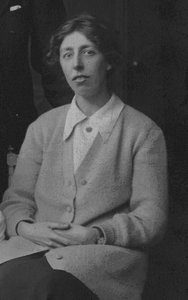Muriel Wheldale Onslow facts for kids
Quick facts for kids
Muriel Wheldale Onslow
|
|
|---|---|
 |
|
| Born |
Muriel Wheldale
31 March 1880 Birmingham, England
|
| Died | 19 May 1932 (aged 52) Cambridge
|
| Education | University of Cambridge |
| Known for | Inheritance of flower colour |
| Spouse(s) | Victor Alexander Herbert Huia Onslow (died 1922) |
| Children | None |
| Awards | Bathurst studentship (1904); |
| Scientific career | |
| Fields | Biochemistry, botany |
| Institutions | John Innes Horticultural Institution, University of Cambridge |
| Influences | William Bateson, Frederick Gowland Hopkins |
| Influenced | Rose Scott-Moncrieff |
Muriel Wheldale Onslow (born March 31, 1880, died May 19, 1932) was an important British scientist. She was a biochemist, which means she studied the chemistry of living things. Muriel was born in Birmingham, England. She is famous for her work on how flower colors are passed down from one generation to the next. She studied the bright colors of snapdragon flowers and the chemicals that make them, called anthocyanins. Muriel went to King Edward VI High School and then Newnham College, Cambridge. She was one of the first women to become a lecturer at Cambridge University.
Contents
Early Life and Education
Muriel Wheldale Onslow was the only child of John and Fannie Wheldale. Her father was a lawyer. She went to King Edward VI High School in Birmingham. This school was known for teaching science well to girls.
In 1900, Muriel started at Newnham College in Cambridge. She studied botany, which is the study of plants. She did very well in her science exams in 1902 and 1904. Even though she earned top marks, the University of Cambridge did not give degrees to women until 1948. So, Muriel could not officially get her degree at that time.
Personal Life
In 1919, Muriel married Victor Alexander Herbert Huia Onslow. He was also a biochemist. They worked closely together on their research. Victor had been paralyzed from the waist down after a diving accident. He passed away in 1922. Muriel wrote that he was very brave and smart, and he was able to have a career in biochemistry with her help.
Muriel loved to travel, especially to Eastern Europe. She died at her home in Cambridge on May 19, 1932.
Scientific Career and Discoveries
Muriel's early work was supported by special grants and fellowships. In 1903, she joined William Bateson's genetics group at Cambridge. Bateson was a famous English biologist who first used the word "genetics." He helped make Gregor Mendel's ideas about heredity (how traits are passed down) popular.
Studying Flower Color Inheritance
Muriel started studying how petal colors were passed down in Antirrhinum plants, also known as snapdragons. She and Bateson's team did many experiments with plants and animals. By 1906, she had enough information to explain how snapdragon colors were inherited.
In 1907, Muriel published her findings. She explained a process called epistasis. This is when one gene can hide or change the effect of another gene. Her studies on flower color gained her a lot of recognition. She published several more papers on this topic between 1909 and 1910.
Biochemistry of Plant Pigments
Muriel was very interested in the chemistry behind the petal colors. She wanted to know what chemicals made the flowers so colorful. Her research on anthocyanin pigments led to her first book, The Anthocyanin Pigments of Plants, published in 1916. This book was important because it was one of the first times someone used chemistry to explain genetic information. This helped bring together the fields of genetics and biochemistry.
Work at John Innes Centre and Cambridge
From 1911 to 1914, Muriel worked at the John Innes Horticultural Institution. Besides her lab work, she was also a talented artist. She could draw plants and capture their exact colors. In 1913, she became one of the first three women to join the Biochemical Club (now called the Biochemical Society).
In 1914, she returned to Cambridge University. She joined the biochemistry lab of Frederick Gowland Hopkins. Here, she continued to study the chemical side of petal colors. She also worked on how fruits ripen. From 1917 to 1922, she worked with her husband, Victor Onslow, on the colors of insect scales. In 1925, she updated her book, The Anthocyanin Pigments of Plants, to include new discoveries.
Pioneering Biochemical Genetics
Muriel Onslow was one of the first scientists to combine genetics and biochemistry. This new field is called biochemical genetics. Her work paved the way for other famous scientists like Edward Tatum and George Beadle.
In 1926, she became one of the first women to be appointed as a University Lecturer at Cambridge. She taught plant biochemistry. Students found her to be an inspiring teacher. Her course was a key part of the advanced botany program.
One of her students, Rose Scott-Moncrieff, went on to identify the first crystalline form of primulin around 1930. This was the first time an anthocyanin pigment had been identified in its pure, crystalline form. Muriel Onslow and Rose Scott-Moncrieff are often credited with starting the field of biochemical genetics.
Legacy and Recognition
Muriel Wheldale Onslow's contributions are still remembered today.
- There is a special prize and research fellowship named after her at Newnham College, Cambridge.
- In 2010, a play called Blooming Snapdragons was performed. It was about four early 20th-century women biochemists, and Muriel Onslow was one of them. The play was created for the John Innes Centre, where she once worked.
Books by Muriel Onslow
- The Anthocyanin Pigments of Plants, 1916 (revised in 1925)
- Principles of Plant Biochemistry, Volume 1, 1931
Images for kids
See also
 In Spanish: Muriel Wheldale Onslow para niños
In Spanish: Muriel Wheldale Onslow para niños


